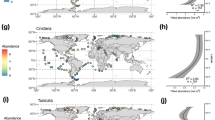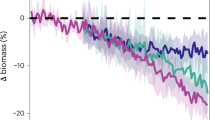Abstract
Planktonic copepods are primary consumers in the ocean and are perhaps the most numerous metazoans on earth. Secondary production by these zooplankton supports most food webs of the open sea, directly affecting pelagic fish populations and the biological pump of carbon into the deep ocean. Models of marine ecosystems are quite sensitive to the formulation of the term for zooplankton mortality1,2,3,4, although there are few data available to constrain mortality rates in such models. Here we present the first evidence for nonlinear, density-dependent mortality rates of open-ocean zooplankton. A high-frequency time series reveals that per capita mortality rates of eggs of Calanus finmarchicus Gunnerus are a function of the abundance of adult females and juveniles. The temporal dynamics of zooplankton populations can be influenced as much by time-dependent mortality rates as by variations in ‘bottom up’ forcing. The functional form and rates chosen for zooplankton mortality in ecosystem models can alter the balance of pelagic ecosystems1,2,3, modify elemental fluxes into the ocean's interior5, and modulate interannual variability in pelagic ecosystems6.
This is a preview of subscription content, access via your institution
Access options
Subscribe to this journal
Receive 51 print issues and online access
$199.00 per year
only $3.90 per issue
Buy this article
- Purchase on Springer Link
- Instant access to full article PDF
Prices may be subject to local taxes which are calculated during checkout



Similar content being viewed by others
References
Steele, J. H. & Henderson, E. W. The role of predation in plankton models. J. Plank. Res. 14, 157–172 (1992).
Fasham, M. J. R. Variation in the seasonal cycle of biological production in subarctic oceans: a model sensitivity analysis. Deep-Sea Res. 42, 1111–1149 (1995).
Edwards, A. M. & Yool, A. The role of higher predation in plankton population models. J. Plank. Res. 22, 1085–1112 (2000).
Carlotti, F., Giske, J. & Werner, F. Zooplankton Methodology Manual (eds Harris, R. P., Wiebe, P. H., Lenz, J., Skjoldal, H. R. & Huntley, M.) 571–667 (Academic, San Diego, 2000).
Fasham, M. J. R. The Global Carbon Cycle (ed. Heinmann, M.) 457–504 (Springer, New York, 1993).
Li, M., Gargett, A. & Denman, K. What determines seasonal and interannual variability of phytoplankton and zooplankton in strongly estuarine systems? Application to the semi-enclosed estuary of Strait of Georgia and Juan de Fuca Strait. Estuar. Coast. Shelf Sci. 50, 467–488 (2000).
Heath, M. R. The ascent migration of Calanus finmarchicus from overwintering depths in the Faroe–Shetland Channel. Fish. Oceanogr. (Suppl. 1) 8, 84–99 (1999).
Richardson, K., Jonasdottir, S. H., Hay, S. J. & Christoffersen, A. Calanus finmarchicus egg production and food availability in the Faroe–Shetland channel and northern North Sea: October–March. Fish. Oceanogr. (Suppl. 1) 8, 153–162 (1999).
Niehoff, B. et al. A high frequency time series at Weathership M, Norwegian Sea, during the 1997 spring bloom: the reproductive biology of Calanus finmarchicus. Mar. Ecol. Prog. Ser. 176, 81–91 (1999).
Irigoien, X. et al. A high frequency time series at weathership M, Norwegian Sea, during the 1997 spring bloom: feeding of adult female Calanus finmarchicus. Mar. Ecol. Prog. Ser. 172, 127–137 (1998).
Meyer-Harms, B., Irigoien, X, Head, R. & Harris, R. Selective feeding on natural phytoplankton by Calanus finmarchicus before, during, and after the 1997 spring bloom in the Norwegian sea. Limnol. Oceanogr. 44, 154–165 (1999).
Wood, S. N. Obtaining birth and mortality patterns from structured population trajectories. Ecol. Monogr. 64, 23–44 (1994).
Aksnes, D. L., Miller, C. B., Ohman, M. D. & Wood, S. N. Estimation techniques used in studies of copepod population dynamics—a review of underlying assumptions. Sarsia 82, 279–296 (1997).
Campbell, R. G., Wagner, M. M., Teegarden, G. J., Boudreau, C. A. & Durbin, E. G. Growth and development rates of the copepod Calanus finmarchicus reared in the laboratory. Mar. Ecol. Progr. Ser. (in the press).
Solow, A. R. & Steele, J. H. Scales of plankton patchiness: biomass versus demography. J. Plank. Res. 17, 1669–1677 (1995).
Hainbucher, D. & Backhaus, J. O. Circulation of the eastern North Atlantic and north-west European continental shelf—a hydrodynamic modelling study. Fish. Oceanogr. (Suppl. 1) 8, 1–12 (1999).
Miralto, A. et al. The insidious effect of diatoms on copepod reproduction. Nature 402, 173–176 (1999).
Hirche, H.-J., Brey, T. & Niehoff, B. A high frequency time series at Weathership M, Norwegian Sea: population dynamics of Calanus finmarchicus. Mar. Ecol. Prog. Ser. (in the press).
Ohman, M. D. & Runge, J. A. Sustained fecundity when phytoplankton resources are in short supply: omnivory by Calanus finmarchicus in the Gulf of St. Lawrence. Limnol. Oceanogr. 39, 21–36 (1994).
Rothschild, B. J. & Osborn, T. R. Small-scale turbulence and plankton contact rates. J. Plank. Res. 10, 465–474 (1988).
Landry, M. R. Switching between herbivory and carnivory by the planktonic marine copepod Calanus pacificus. Mar. Biol. 65, 77–82 (1981).
Landry, M. R. Population dynamics and production of a planktonic marine copepod, Acartia clausii, in a small temperate lagoon on an Juan Island, Washington. Int. Rev. Ges. Hydrobiol. 63, 77–119 (1978).
Uye, S. I. & Liang, D. Copepods attain high abundance, biomass and production in the absence of large predators but suffer cannibalistic loss. J. Mar. Sys. 15, 495–501 (1998).
Peterson, W. T. & Kimmerer, W. J. Processes controlling recruitment of the marine calanoid copepod Temora longicornis in Long Island Sound: egg production, egg mortality, and cohort survival rates. Limnol. Oceanogr. 39, 1594–1605 (1994).
Daan, R., Gonzales, S. R. & Klein Breteler, W. C. M. Cannibalism in omnivorous calanoid copepods. Mar. Ecol. Prog. Ser. 47, 45–54 (1989).
Ohman, M. D., Durbin, E. G. & Runge, J. A. Density-dependence of instantaneous mortality rates of Calanus finmarchicus on Georges Bank. EOS Trans. Am. Geophys. Union 79, OS155 (1998).
Planque, B. & Taylor, A. H. Long-term changes in zooplankton and the climate of the North Atlantic. ICES J. Mar. Sci. 55, 644–654 (1998).
Lynch, D. R., Gentleman, W. C., McGillicuddy, D. J. Jr & Davis, C. S. Biological/physical simulations of Calanus finmarchicus population dynamics in the Gulf of Maine. Mar. Ecol. Prog. Ser. 169, 189–210 (1998).
Cowan, R. K., Lwiza, K. M. M., Sponaugle, S., Paris, C. B. & Olson, D. B. Connectivity of marine populations: open or closed? Science 287, 857–859 (2000).
Heath, M. R. et al. Climate fluctuations and the spring invasion of the North Sea by Calanus finmarchicus. Fish Oceanogr. (Suppl. 1) 8, 163–176 (1999).
Acknowledgements
We thank the late M. M. Mullin for his scientific insights, the captain and the crew as well as the scientists (X. Irigoien, U. Klenke, R. Head) on the vessel Polarfront for their support, and the Institute for Marine Research (Bergen, Norway), which provided logistical help. B. Niehoff provided egg-production rates, S. Jaklin and E. Mizdalski helped with analysing the samples and A. De Robertis generated bootstrap confidence intervals. This work was supported by funding from the European Commission through the TASC project and by the National Science Foundation and the National Oceanic and Atmospheric Administration through US GLOBEC (Global Ocean Ecosystem Dynamics).
Author information
Authors and Affiliations
Corresponding author
Rights and permissions
About this article
Cite this article
Ohman, M., Hirche, HJ. Density-dependent mortality in an oceanic copepod population. Nature 412, 638–641 (2001). https://doi.org/10.1038/35088068
Received:
Accepted:
Issue Date:
DOI: https://doi.org/10.1038/35088068
This article is cited by
-
Effects of Leachates from Hydrothermal Ore Particulates on Life Cycle Parameters and Expression of Defense-Related Genes in the Marine Copepod Tigriopus japonicus
Water, Air, & Soil Pollution (2022)
-
Annual Occurrence of Calanus sinicus Carcasses in the Jiaozhou Bay and the Adjacent Waters
Journal of Ocean University of China (2020)
-
Non-predatory mortality in Mediterranean coastal copepods
Marine Biology (2017)
-
Diversity patterns and biogeography of Diaptomidae (Copepoda, Calanoida) in the Western Palearctic
Hydrobiologia (2017)
-
The role of local and regional environmental factors for Calanus finmarchicus and C. hyperboreus abundances in the Nordic Seas
Polar Biology (2017)
Comments
By submitting a comment you agree to abide by our Terms and Community Guidelines. If you find something abusive or that does not comply with our terms or guidelines please flag it as inappropriate.



